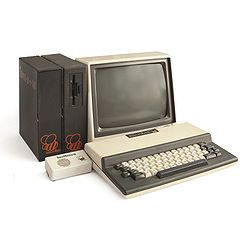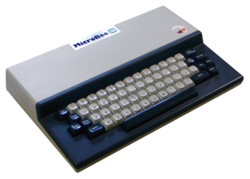- MicroBee
-
MicroBee 
Developer Applied Technology Release date June 1982 Introductory price 399 AU$ in Kit Form Discontinued 1990 Operating system MicroWorld BASIC
DGOS (David Griffiths Operating System)CPU Zilog Z80 @ 2 MHz Memory 16 kB or 32 kB Graphics Synertek 6545 CRT controller for 64 × 16 characters (512 × 256 pixels) Sound Monotonic sound generator & speaker, 2 octaves MicroBee (Micro Bee) was a series of home computers by Applied Technology, later known as MicroBee Systems.
The original MicroBee computer was designed in Australia by a team including Owen Hill[1] and Matthew Starr. It was based on features available on the DG-Z80 and DG-640 S-100 cards developed by David Griffiths, TCT-PCG S-100 card developed by TCT Micro Design and MW6545 S-100 card developed by Dr John Wilmshurst. It was originally packaged as a two board unit, with the lower "main board" containing the keyboard, Zilog Z80 microprocessor, Synertek 6545 CRT controller, 2 kB of "screen" RAM, 2 kB of character ROM (128 characters) and 2 kB of Programmable Character Graphics (PCG) RAM (128 characters). Each byte in the screen RAM addressed a character in either the character ROM or PCG RAM. A second board, termed the "core board", contained the memory, and on later models also included a floppy disk controller.
Contents
Kit beginnings
The computer was conceived as a kit, with assembly instructions included in Your Computer magazine, in June 1982.[2] After a successful bid for the New South Wales Department of Education computer tender, the computer was repackaged in a two-tone beige and black case, and sold pre-built. The 16 kB ROM held the MicroWorld BASIC interpreter written by Matthew Starr and DGOS (David Griffiths Operating System) compatible System Monitor. In addition to the 16 kB ROM, there is additional ROM socket for optional programs such as WORDBEE (Word processor) or EDASM (a Z80 Editor/Assembler that was written by Ron Harris).[3]
Original MicroBees ran at a clock speed of 2 MHz, with a video dot clock of 12 MHz, which was sufficient to display 64 × 16 characters (512 × 256 pixels) on a modified television or composite monitor. The original machines were supplied with 16 or 32 kB of static RAM, and stored programs on cassette, using Kansas City standard and 1200 Baud encoding.
The IC model
The IC model was released in 1983, increasing the clock speed to 3.375 MHz, and allowing (through use of a 13.5 MHz video clock) display of 80 × 24 characters (640 × 264 pixels), again on a modified television or composite monitor. It also included a 4 kB "Telcom" terminal emulator ROM.
Disk machines
A floppy disk based machine was also released in 1983. Early disk machines used 56 kB of static RAM, with a 4 kB BIOS ROM. They ran CP/M 2.2. The disk controller, based on the Western Digital WD1793 Floppy Disk Controller chip was contained in an add-on card that connected to the core board. The machines uses 5.25" floppy disks.
Dynamic RAM disk machines with 64 or 128 kB RAM followed soon after, with a WD2793 Floppy Disk Controller incorporated on the core board. Later disk machines used 3.5" floppy disks.
Colour
A colour machine was also released in 1983, called the "32K Personal Communicator". This added a second byte of RAM for each character position, allowing each character to have 2 colours from a palette of 16. The extra circuitry was contained on an additional board mounted under the main board, with numerous messy connections to the main board.
The B-ETI Serial Terminal
The B-ETI was a Microbee based serial terminal. It could emulate either an ADM-3A or Televideo 912 terminal. The display format was monochrome 80 × 24 and it supported communication at either 300 or 1200 baud. An advertisement for a "special introductory offer" with an asking price of 275 AU$ appeared in the December 1983 issue of Electronics Today International magazine.[4]
The Premium Series MicroBee
In 1985, a new mainboard was introduced. The resulting machine was called the "Premium Series" model. The new mainboard had 8 kB of screen RAM, 8 kB of "attribute" RAM (raising the possible number of PCG characters to 32 768), 8 kB of colour RAM, and up to 32 kB (16 kB installed) of PCG RAM. 16 kB PCG RAM was sufficient to allow full 512 × 256 bit mapped displays with a limited colour palette. These machines were typically sold with dual-floppy drives (or a 10 MB 'Winchester' disc) held in a monitor stand that connected to the main unit.
Physical coding for tape storage
MicroBee computers, at least MicroBee 32 use 300 or 1200 baud and conforms loosely to the "Kansas City Standard". A frequency of 1200 Hz means "1", 2400 Hz means "0". At 300 bit/s, one bit lasts 1000 µs, at 1200 bit/s, one bit lasts 250 µs.
The bit stream is stored as, Start bit - 0, LSB....MSB, 2 stop bits.
The wav2dat software converts audio data into Microbee files.
Games
Many memorable games were written for the Microbee, including:
- Asteroids
- Emu Joust - a Joust clone
- Ghost Muncher - a Pac-Man clone
- Halloween Harry
- Hoards of the Deep Realm
- Kilopede - a Centipede clone
- Microspace Invaders
- Robotman - a Pac-Man clone by Paul Wilmhurst[5]
- Wumpus
- Cricket
- Toady - a word guessing game
- Lemonade Stall - a game for budding business entrepreneurs.
- Underworld of Kyn - By Andy William Farrell
- Sword Quest - a dungeons and dragons style game by P Jepson and C Temple
As well, numerous adventure games were written, mainly in BASIC, plus educational software.[6][7][8]
Final versions
The final version of the MicroBee, released in 1987, was the 256TC. This increased the memory to 256 kB of dynamic RAM and had a new keyboard with numeric keypad. The computer had a built in 3.5" floppy disk drive supporting both 800 kB (DSDD) and 400 kB (SSDD) formats. Bundled software included "Videotex" a videotex terminal program, "Simply Write" (a word processor) and "Telcom" (a serial terminal emulator program).
MicroBee Systems also designed a PC clone, called the "Matilda", or 640TC, which ran an NEC V20 chip, and emulated the MicroBee CP/M systems in software.
An advanced next generation model code named "Gamma", based on the Motorola 68010 and two Zilog Z80 processors, was designed but never made it to the market.[9][10]
Emulators
- freshmeat.net - Stewart Kay's "uBee512" Microbee emulator - Emulates all (Z80) 56-512K FDD, Standard/Premium/Teleterm 256TC, and 32K ROM based models.
- nanowasp.org - A Microbee Emulator -"Nanowasp"
- mess.org - Microbee on the MESS (Multi Emulator Super System)
References
- ^ Secret of project Granny Smith By Gordon Laing, July 12, 2005 - theage.com.au
- ^ Microbee computer, From:Owen Hill Date:24 Aug 1998, Link list on Australian network policy and communications
- ^ Graphic Word bee user's manual by Ron Harris and Gordon Rowell, Honeysoft, c1985., National Library of Australia
- ^ B-ETI Advertisement. (December 1983). Electronics Today International, p. 51.
- ^ MBEE - Microbee (Australian), The Giant List of Classic Game Programmers
- ^ Chilly Willy & Halloween Harry by John Passfield
- ^ Hoards of Deep Realm
- ^ Ring of Doom / Ödesringen, Produced by: Microworld, Author: Chris Peters, Year: 1983, System: Microbee, Type: Text adventure ,Tolkien computer games
- ^ Microbee Systems:WHEN OWEN HILL STOOD STILL An interview with Owen Hill, founder of Microbee Systems. Published in Your Computer, February 1986.
- ^ Gamma, Microbee, The As-Yet Unnamed Computer Museum!!
External links
- The Microbee Beeboard - Discussion Forum (Since 2002)
- The Microbee Beeboard Virtual Museum
- Microbee Beeboard - File Repository (Games, ROMs, Disks, Utilities & Documentation)
- The Microbee Software Preservation Project (MSPP)
- The Microbee story[dead link]
- Microbee microcomputer micro-FAQ[dead link]
- Australian Computer Museum Society Inc microbee page
- The PC Museum, Applied Technology page
- Matthew Geier's notes and pictures, including a working "Gamma"
- Alistair Shilton's "Archaic Electronics Labyrinth" including a page (Picomozzy - the Microbee 32k Emulator) with scans of Microbee technical reference manuals[dead link]Archived version
- OLD-COMPUTERS.COM's page dedicated to the Microbee systems
- The Microbee Archive[dead link]Archived version
- Microbee Documentation Project
- The Powerhouse Museum (Sydney Australia) - K1431 Microcomputer, "Microbee" 16KROM, early Kit computer.
Categories:- Home computers
Wikimedia Foundation. 2010.


